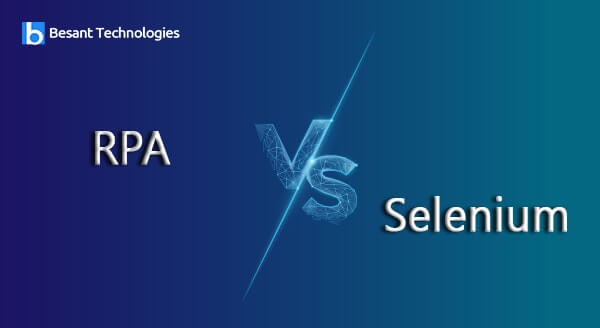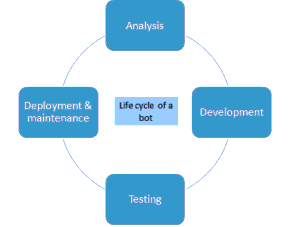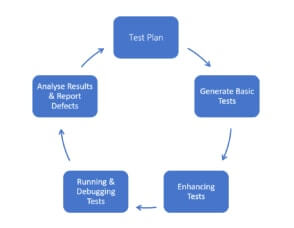
RPA VS Selenium
RPA VS Selenium
In today’s world, technology has reached an apex level and the tremendous growth of automation has added more wings to this transformation. From automating a simpler unit to whole business operation, technology has evolved to the fullest.
Computers have been evolving at a tremendous pace from their initial uses and role of as a storage and calculations device to electronic brain and control centers. This gave rise to an unimaginable level of tools and applications for different purposes and requirements.
RPA and Selenium are two distinct parts of the new age computer era that performs tasks that are completely distinct and yet related to one another. They depend on and influence each other in the end product or service achieved. Both are on and off-screen performers and an inevitable part of the computerization revolution wave across the globe.
In recent years, technology has reached higher heights and the development of automation added more advantages to these changes. It all started with the automation of easy unit test cases to the automation of the full business process. In this article, we will see the major differences between RPA and Selenium and the below topics will be discussed as part of this article.
- Selenium and its features
- RPA and its features
- Major differences between RPA and Selenium
What is Robotic process automation?
RPA –Standing short for Robotic Process Automation, is based on artificial intelligence and primarily used in applications that require repetitive action coordination. Recordkeeping, data analysis and most importantly jobs that require replicating a human action. Jobs that require complex calculations, accuracy, and precision are now being assigned to robots to get the task done efficiently. With a growing number of industrial and business segments relying on automation of their operations, RPA is at its full bloom in recent years from flying unmanned flights to complex surgeries on humans.
Robotic Process Automation (RPA) helps in automating repetitive tasks without using the human mind and power. This is a kind of technology that consists of software robots that can mimic a human worker. There are a lot of things that RPA bots can do such as entering data, logging into applications, accomplishing tasks and then log out.
RPA is not a part of the IT program of an organization in most cases due to the high cost involved. This, in turn, increases the cost of development as its not commercially high in demand it’s customized and developed for specific purposes.
RPA stands for Robotic Process Automation. It is an automation technology which helps to automate the repetitive tasks without the intervention of humans. RPA was formed with the perception of authorizing business users for making software bots which is able to interact with a system like a human. RPA came into the business from 3 main predecessors namely,
- Screen Scraping
- Workflow automation
- Artificial intelligence
Screen scraping: It plays a vital role in the fields of data integration and data migration. It created a connection between legacy and the current system. It was a major component which is used to collect display data in one application, translating it thereby other application will display the data.
Workflow Automation: It means automating and executing the business process in which tasks are completed based on the set of predefined rules. This will help to design low code plans, less effort execution, optimization of workflow.
Artificial Intelligence: It is completely a different concept which deals with simulating the human intelligence of machines. It instructs the system to do all assigned tasks which the user needs to do. It helps in the development of business and industry transformation. Deep learning and Machine learning helps in implementing AI.
RPA is a combined form of Automation and Artificial intelligence. It is platform-independent. Some human actions like logging into the application, copy-paste the date, moving the folders or files, form filling, extraction of data from the documents are done by RPA bots.
Click Here -> Get Prepared for Interviews
Features of RPA
Listed below are the features of using RPA.
- With the aim of empowering businesses, RPA primarily creates software bots that could work easily with the system.
- RPA bots help to manage and perform a multitude of human actions such as move files and folders, fill forms, copy and paste data, to name a few.
- It is highly reliant on workflow automation and screen scraping.
- RPA is nothing but a blend of Automation and AI (Artificial Intelligence).
- Software bots are the potential way that helps the organization to attain cost savings.
- RPA will be a better option for repetitive tasks.
- It will reduce the maximum number of errors
- it is used in the different business processes such as calculations, operation activities and extraction of data.
- The more precise result is obtained by using RPA in very less time.
- While using RPA, the risk factor is reduced and the data is highly protected.
Accuracy at high volumes
When humans are assigned Jobs that are repetitive and uniform in nature there is a big element of boredom involved which decreases productivity and adds chances of error. These are the areas where RPA comes into play where artificial intelligence performs the task flawlessly in high volumes. This includes data analyzing.
Increased productivity
When machines are assigned with the boring part of the job, the saved human hours can be used more efficiently in monitoring and areas of the job that would require out of the box thinking and creativity which is an incapability of machines.
Affordability
Most businesses cannot afford RPA due to the high cost that is involved in developing and applying hence it is popular only among the big investors and hence not a part of the general gadgets of a company.
Click Here -> Get RPA Training
What is Selenium?
Selenium is a free testing suite that is quite similar to HP Quick Test Pro and emphasis mainly on automating web-based applications. Selenium as an automation tool was developed by Thoughtworks in early 2000. it was developed through various languages eventually when in 2006, under Simon Stewart reworked and left behind the initial advantages. The finally developed Selenium Web driver was achieved by merging Web driver and Selenium remote control.
Selenium, in other words, is a set of different software tools that helps support test automation. Having observed that there a lot of Selenium Quality Analyst engineers primarily emphasis focus on one or two tools that can carry out their objectives perfectly. However, when you have knowledge of all the tools, it will provide you with a multitude of options for approaching different test automation problems.
Selenium being a tool for testing web applications serves a completely different purpose as opposed to that of Robotic process automation which is more about, with ever-growing popularity among automated testing developers and professionals who had been traditionally using manual testing tools. The function is also to provide a language that is specific test domain for test in popular languages in programming like java, scala and more.
Selenium is a free open source automation testing tool which is used for testing web applications in different platforms and browsers. It is the top-level technology for web application testing. Selenium components are mainly classified into 4 divisions. They are
- WebDriver
- Selenium Grid
- Selenium Remote Control(RC)
- Selenium Integrated Development Environment (IDE)
Click Here -> Get Free Selenium Tutorial
Features of Selenium
- Selenium is a free open source framework that is used for testing the web applications.
- Different types of programming languages like Python, Java, Ruby, etc., are used for writing the test scripts in Selenium. Because of user-friendly habit, Java will be used commonly.
- Testing in cross-browser is supported in Selenium. Test scripts in Selenium will run on a different browser such as Internet Explorer, Google Chrome, and Safari, etc.
- Selenium is mainly used for both regression testing as well as functional testing
- Selenium is used only for testing the web application. Mobile and Desktop application testing is not possible through selenium.
- Selenese is the set of commands used in Selenium IDE which is used to run the tests.
- Element locators are used to identifying the elements in the web page easily and quickly
Selenium is popular among developers and programmers due to many key features and this popularity not expected to be replaced or overtaken by another in the near feature. The following are some of the features
Free open-source tool
Being a free service that supports a large number of testing functions, selenium is more popular than ever. Not being charged for the test functions is a key feature that propels selenium.
Huge browser support
With the backing of some of the largest browsers selenium is soon to be more renowned and take its own permanent space in the native part of a browser.
Language support
Though Selenium comes with its own scripts is not limited by language and gives the testers flexibility of using including groovy, Perl, Python, Ruby, Java, c#, Perl, Python, etc. This is one of the main reasons for the rising popularity among users.
Add on and Usability
The access and support from various browsers mean that Selenium is sometimes blamed as a not fully functional as it depends on third party frameworks for the ad on. This is a subject of debate as it also gives the flexibility of going by the style and approach of the programmer.
Combination of Tool and DSL
There is no arguing with the fact that Selenium is an absolute combination of tools and Domain Specific Language that help execute special kinds of various types of tests. In addition, you can even record the tests carried out through the browser. It supports multiple web browsers like Chrome, Internet Explorer, Firefox, Safari, etc.
Uses a Rich Language for Tests
To test web applications, Selenium uses DSL in order. This is an easy programming language to learn and includes more than 200 commands.
A Versatile language
Once you are done preparing the test cases, they can be executed on any operating system like Linux, Macintosh, etc.
Reduce Test Execution Time
Selenium does support parallel test execution which ultimately minimizes the time taken in executing parallel tests.
Lesser Resources Required
When compared to its competitors like UFT, and RFT, Selenium requires lesser resources.
Click Here -> Get Selenium Interview Questions and Answers
Similarities between Selenium and RPA
Though the features and functions actioned by both Selenium and RPA are different they do cross paths and share the job of making the management or process of business smoothly and tackling situations like eliminating human error, repetitive and boring tasks being made more efficient. Both are production data-driven and have a structured and rule-based flow.
Both RPA and Selenium are necessary to support each other for an error-free functioning of the established project.
Differences between RPA and Test automation
A major difference is that RPA, unlike Test automation, performs in the front line of the business in the visible spectrum while the latter is more of a player behind the screen who manages the show without taking much of the visible credits. This sometimes creates a situation where the effort, time and skill involved in the testing area is often under-appreciated or overlooked. Though this does create a dig in the mind of the programmers not being credited for the efforts against the installation of RPA often over appreciated.
Most automation tools don’t match the requirement of an establishment due to the lack of features to supervise and audit trials, whereas in most cases test automation ignites RPA projects as they open up new doors of opportunities of automation potentials. This is important as the long term investment in automation is huge and often time-consuming hence to justify the effort such strategies are necessary.
The major difference between RPA and Selenium
Below factors are used to compare RPA and Selenium:
- What does RPA and Selenium tools will automate?
- Where automation will take place
- Tools are paid or open-sourced?
- RPA and Selenium – Major Components
- The automation level of RPA and Selenium
- Life Cycle complexity
- Coding knowledge- Required or not?
What does RPA and Selenium tools will automate?
- Selenium is used for automating web application testing.
- RPA is used for automating business processes like queries, record maintenance, calculation, processing of transactions.
Where automation will take place.
- Selenium will automate the web page.
- RPA will automate the backend process which is time-consuming.
Tools are paid or open-sourced?
- Selenium is a free and open-source tool.
- Various RPA tools like Automation Anywhere, UiPath, Bluprism are available in the market. The community edition of the UiPath tool is free and the business edition is licensed.
RPA and Selenium – Major Components
- Selenium components are as follows:
- WebDriver
- Selenium Grid
- Selenium Remote Control(RC)
- Selenium Integrated Development Environment (IDE)
- RPA uses bots that are powerful in imitation certain human activities.
The automation level of RPA and Selenium
- RPA will help to maintain a large amount of data. It will simplify the process. It is good in the clerical process.
- Selenium will not support the clerical process. It will work in front end applications.
Life Cycle complexity
The life cycle of Selenium is more complicated than RPA. Let us discuss the life cycle of RPA and Selenium tools in detail below
Life Cycle of RPA:
The life cycle of RPA consists of the following steps, namely
- Analysis
- Development of Bot
- Testing
- Deployment and Maintenance

Life Cycle of Selenium:
- Test plan
- Generation of basic test case
- Enhancement of test case
- Execution and Debugging of test case
- Test result analysis and Defect reporting

Coding knowledge- Required or not?
- Selenium requires fundamental knowledge in JAVA
- Minimum knowledge of coding is required for RPA
Comparison of RPA & Selenium
Here is how RPA is different from Selenium
- Selenium helps automate only the current web page while RPA automates all the backend processes that are time-consuming.
- Selenium is an open-source testing tool whereas RPA contains tools such as UiPath, Automation Anywhere, Blue Prism and others.
- RPA helps in maintaining huge records of data and the best part is that it is flexible in dealing with the clerical processes. Selenium does not support the clerical processes as it works on the front end of the web application.
- Keep this in mind that the simpler their life cycle is, the more efficient they will be. Selenium has a complicated life cycle compared to RPA.
- When it comes to automating the test cases, the web driver plays a very important role in because it overcomes all the disadvantages of Selenium, making the process much simpler. With the help of bots, RPA helps in rendering possible outcomes by imitating the activities of humans.
- If you are working with Selenium, then it is important for you to be proficient with Java language. On the other hand, RPA requires coding knowledge but at a minimal level.
- Both Selenium and RPA are automation tools that help minimize manual intervention while enhancing quality.
- RPA streamlines the process by simplifying the order entry while Selenium performs actions like login, sign up and entry.
Conclusion
Comparing both the software’s, their functions we can conclude that they are both designed to perform two distinct functions. They are not in competition with each other but two very important aspects of the software that depend on each other for achieving the desired result. The generally seen comparison across the two doesn’t stand . We can also understand that testing software’s are necessary tool all across the operation of an organization hence it’s a daily tool and cost-effective and amendable to updates wherever required whereas an RPA is more specific to the industrial requirements and not just in the initial stage but right across the implementation of the automation system many global factors like the lack of desired skills, employee turnover and requirement of higher volume of products and services are driving full-scale automation of sectors of business that were traditionally manpower dominated. The future definitely looks bright for the combination.
Click Here -> Get Selenium Training

